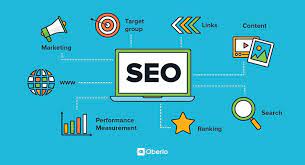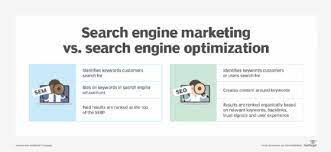SEO: Unlocking the Power of Search Engine Optimization
In today’s digital age, having a strong online presence is crucial for businesses of all sizes. With millions of websites competing for attention, how can you ensure that your website stands out from the crowd? This is where search engine optimization (SEO) comes into play.
What is SEO?
SEO, or search engine optimization, is the practice of optimizing your website to improve its visibility and ranking on search engine results pages (SERPs). In simpler terms, it’s about making your website more visible to people who are searching for products or services related to your business.
Why is SEO important?
Research has shown that most internet users rely on search engines like Google to find information. When someone searches for a specific keyword or phrase, search engines use complex algorithms to determine which websites should be displayed on the first page of results. Studies have also found that users are more likely to click on websites that appear higher in the rankings.
By implementing effective SEO strategies, you can increase your website’s chances of ranking higher in search results. This means more visibility, more organic traffic, and ultimately, more potential customers.
How does SEO work?
SEO involves various techniques and practices aimed at improving different aspects of your website. Here are some key elements:
Keywords: Researching and selecting relevant keywords that align with your business and target audience is essential. These keywords should be strategically placed throughout your website’s content, including headings, titles, meta descriptions, and body text.
On-Page Optimization: This refers to optimizing individual pages on your website by ensuring they have unique and engaging content, proper formatting (such as using header tags), optimized images with alt tags, and user-friendly URLs.
Technical SEO: This focuses on optimizing the technical aspects of your website so that search engines can crawl and index it effectively. It includes tasks such as improving site speed, fixing broken links, and optimizing mobile responsiveness.
Link Building: Building high-quality backlinks from reputable websites is an important aspect of SEO. These links act as endorsements for your website’s credibility and authority, signaling to search engines that your content is valuable.
User Experience: Search engines prioritize websites that provide a positive user experience. Factors such as page load speed, mobile-friendliness, easy navigation, and engaging content all contribute to a better user experience.
The Benefits of SEO
Investing in SEO can yield numerous benefits for your business:
Increased Visibility: By ranking higher in search results, you increase the chances of potential customers finding your website organically.
Targeted Traffic: SEO helps attract relevant traffic to your website by targeting keywords and phrases that align with your business offerings.
Cost-Effective: Compared to other forms of digital marketing, SEO offers a high return on investment (ROI) as it focuses on organic traffic rather than paid ads.
Brand Credibility: Higher rankings on search engines help establish trust and credibility with potential customers who view top-ranked websites as more reputable.
Long-Term Results: While SEO requires ongoing efforts, the results are long-lasting compared to paid advertising campaigns that stop once the budget runs out.
Conclusion
In today’s competitive online landscape, having an effective SEO strategy is essential for businesses seeking success. By optimizing your website for search engines, you can increase visibility, attract targeted traffic, and ultimately grow your business. Whether you’re a small startup or an established enterprise, investing in SEO will undoubtedly help you unlock the power of online visibility and reach new heights in the digital realm.
7 Frequently Asked Questions About SEO (Search Engine Optimization) Answered
- What are the 4 types of SEO?
- What does search engine optimization SEO do?
- Can I do SEO on my own?
- What is SEO and how it works?
- What is SEO and optimization?
- How do I Optimise SEO?
- How can I do SEO for my website?
What are the 4 types of SEO?
There are generally four types of SEO, each focusing on different aspects of optimizing a website for search engines:
- On-Page SEO: This type of SEO involves optimizing individual web pages to improve their visibility and ranking on search engine results pages (SERPs). It includes optimizing elements such as content, meta tags, headings, URLs, internal linking, and keyword usage. On-page SEO aims to make the website more relevant and user-friendly for both search engines and users.
- Off-Page SEO: Off-page SEO refers to activities that are done outside of your website to improve its visibility and authority. It primarily focuses on building high-quality backlinks from other reputable websites. These backlinks act as endorsements for your site’s credibility and help search engines understand the importance and relevance of your content.
- Technical SEO: Technical SEO deals with the technical aspects of a website that affect its visibility in search engines. It involves optimizing factors such as website speed, mobile-friendliness, crawlability, indexing, site architecture, structured data markup, XML sitemaps, and more. Technical SEO ensures that search engine crawlers can efficiently access and understand your website’s content.
- Local SEO: Local SEO is specifically targeted at businesses with physical locations or those serving specific geographic areas. It focuses on improving a website’s visibility in local searches by optimizing location-specific keywords, creating and managing Google My Business listings, obtaining online reviews from customers, and ensuring consistent NAP (Name, Address, Phone number) information across various online directories.
It’s important to note that these types of SEO are interconnected and work together to improve a website’s overall performance in search engine rankings. A comprehensive SEO strategy often incorporates elements from all four types to maximize visibility and drive organic traffic to a website.
What does search engine optimization SEO do?
Search engine optimization (SEO) is a practice that aims to improve a website’s visibility and ranking on search engine results pages (SERPs). SEO involves various techniques and strategies that help search engines understand the content of a website and determine its relevance to specific search queries. Here are some key things that SEO does:
- Increases Organic Traffic: By optimizing a website for relevant keywords and improving its overall visibility, SEO helps attract more organic (non-paid) traffic. When a website appears higher in search results, it is more likely to receive clicks from users searching for related information.
- Improves Website Ranking: SEO techniques, such as keyword research, on-page optimization, and link building, help improve a website’s ranking on SERPs. Higher rankings increase the chances of attracting visitors and potential customers.
- Enhances User Experience: SEO focuses not only on search engine algorithms but also on improving user experience. Websites optimized for SEO tend to have faster load times, mobile-friendly designs, easy navigation, and high-quality content that engages visitors.
- Builds Credibility and Trust: Search engines consider numerous factors when ranking websites, including backlinks from reputable sources. By developing a strong backlink profile through effective link building strategies, SEO helps establish credibility and trust with both search engines and users.
- Targets Relevant Audience: SEO allows businesses to target specific keywords or phrases related to their products or services. This helps attract users who are actively searching for what the business offers, increasing the likelihood of conversions.
- Provides Long-Term Results: While SEO requires ongoing efforts to maintain rankings, it provides long-term benefits compared to paid advertising campaigns that stop once the budget runs out. With consistent optimization efforts, a website can maintain its visibility over time.
- Maximizes ROI: Compared to other forms of digital marketing such as pay-per-click (PPC) advertising, SEO offers a higher return on investment (ROI). Once a website achieves higher organic rankings, the traffic it receives is essentially free, reducing the need for continuous ad spend.
Overall, SEO helps businesses improve their online presence, attract targeted traffic, and ultimately increase conversions. It is an essential digital marketing practice for businesses looking to thrive in the competitive online landscape.
Can I do SEO on my own?
Yes, it is possible to do SEO on your own. Many individuals and small businesses choose to handle their SEO efforts internally. However, it’s important to note that SEO can be a complex and time-consuming process that requires a good understanding of various techniques and best practices.
If you decide to take on SEO yourself, here are a few key steps to consider:
- Educate Yourself: Start by learning the basics of SEO through online resources, guides, and reputable websites. Familiarize yourself with concepts such as keyword research, on-page optimization, link building, and technical SEO.
- Conduct Keyword Research: Identify relevant keywords and phrases that align with your business offerings. Use keyword research tools to understand search volume, competition levels, and user intent behind each keyword.
- Optimize On-Page Elements: Ensure that your website’s content is optimized for search engines. This includes incorporating target keywords naturally into titles, headings, meta descriptions, URLs, and body text. Focus on creating high-quality content that provides value to users.
- Build High-Quality Backlinks: Establishing a strong backlink profile is crucial for SEO success. Seek opportunities to earn backlinks from authoritative websites in your industry through guest blogging, content partnerships, or outreach campaigns.
- Improve User Experience: Enhance your website’s usability by optimizing page load speed, ensuring mobile responsiveness, improving navigation structure, and creating engaging content that keeps visitors on your site longer.
- Monitor Performance: Regularly track the performance of your website using analytics tools like Google Analytics or other SEO software. Monitor organic traffic growth, keyword rankings, bounce rates, and conversion rates to gauge the effectiveness of your efforts.
- Stay Updated: SEO algorithms are constantly evolving; staying informed about industry trends and updates is crucial for maintaining an effective strategy. Follow reputable blogs or join online communities to stay up-to-date with the latest developments in the field.
While doing SEO on your own is feasible, it’s important to recognize that it requires time, dedication, and ongoing learning. If you have limited resources or prefer to focus on other aspects of your business, you may consider hiring an experienced SEO professional or agency to handle your SEO efforts and ensure optimal results.
What is SEO and how it works?
SEO, or search engine optimization, is the practice of improving a website’s visibility and ranking on search engine results pages (SERPs). It involves optimizing various aspects of a website to make it more appealing to search engines and users alike.
Search engines like Google use complex algorithms to determine which websites should appear at the top of their search results. SEO aims to understand these algorithms and implement strategies that align with them, ultimately improving a website’s chances of ranking higher.
Here’s a breakdown of how SEO works:
- Keyword Research: SEO begins with thorough keyword research. This involves identifying the specific words and phrases that users are searching for in relation to your business or industry.
- On-Page Optimization: Once keywords are identified, they are strategically incorporated into various elements of a website, including page titles, headings, meta descriptions, URLs, and content. This helps search engines understand the relevance and context of the website’s content.
- Content Creation: Creating high-quality, informative, and engaging content is crucial for SEO. By offering valuable information to users through blog posts, articles, videos, or other forms of media, websites can attract organic traffic and establish themselves as authorities in their respective fields.
- Technical Optimization: Technical SEO focuses on optimizing the technical aspects of a website to ensure it is easily accessible by search engine crawlers. This includes optimizing site speed, improving mobile responsiveness, fixing broken links or errors, implementing proper URL structures, and creating XML sitemaps.
- Link Building: Building high-quality backlinks from reputable websites is an important aspect of SEO. These backlinks act as endorsements for a website’s credibility and authority in the eyes of search engines.
- User Experience: Search engines prioritize websites that provide positive user experiences. Factors such as page load speed, mobile-friendliness, easy navigation, clear site structure, and engaging design all contribute to better user experiences.
- Monitoring and Analysis: SEO is an ongoing process, and it requires continuous monitoring and analysis. By using tools like Google Analytics, website owners can track their website’s performance, measure the effectiveness of SEO strategies, and make necessary adjustments.
The ultimate goal of SEO is to improve a website’s visibility in search results, attract targeted organic traffic, and provide users with a seamless browsing experience. By implementing effective SEO techniques, businesses can increase their online presence, reach their target audience, and drive more conversions.
What is SEO and optimization?
SEO stands for search engine optimization. It is the practice of optimizing a website or web page to improve its visibility and ranking on search engine results pages (SERPs). The goal of SEO is to increase organic (non-paid) traffic to a website by making it more relevant and valuable to search engine algorithms.
Optimization, in the context of SEO, refers to the process of making various improvements and adjustments to a website’s content, structure, and technical elements in order to enhance its visibility and performance on search engines. This includes optimizing keywords, meta tags, headings, URLs, images, site speed, mobile responsiveness, user experience, and more.
By implementing effective optimization techniques, websites can improve their chances of ranking higher on search engine results pages when users search for relevant keywords or phrases. This increased visibility can lead to more organic traffic from users who are actively searching for products or services related to the website’s offerings.
Overall, SEO and optimization work together to help websites attract targeted traffic and improve their online presence by aligning with the criteria set by search engines.
How do I Optimise SEO?
Optimizing SEO involves implementing various strategies and best practices to improve your website’s visibility and ranking on search engine results pages. Here are some key steps to help you optimize your website for SEO:
- Keyword Research: Start by conducting thorough keyword research to identify relevant keywords and phrases that your target audience is likely to search for. Use tools like Google Keyword Planner or SEMrush to find popular keywords with moderate competition.
- On-Page Optimization: Optimize your web pages by incorporating the selected keywords strategically. Ensure that your target keywords are included in the page title, meta description, headings (H1, H2, etc.), and throughout the content naturally. However, avoid keyword stuffing, as it can negatively impact user experience.
- High-Quality Content: Create valuable and engaging content that is relevant to your target audience. Focus on providing informative articles, blog posts, product descriptions, or other types of content that address their needs and interests. Use proper formatting (bullet points, subheadings) to make it easy for users to read and understand.
- Mobile-Friendly Design: With the increasing use of mobile devices, it’s crucial to have a website design that is mobile-friendly and responsive. Ensure that your website adapts well to different screen sizes and loads quickly on mobile devices.
- Page Load Speed: Optimize your website’s load speed as it directly impacts user experience and SEO rankings. Compress images, minify CSS and JavaScript files, enable browser caching, and choose a reliable hosting provider to improve page load times.
- Link Building: Build high-quality backlinks from reputable websites in your industry or niche. Seek opportunities for guest blogging or collaborations with influencers or industry experts who can link back to your website. Quality backlinks help establish credibility and authority in the eyes of search engines.
- User Experience: Enhance user experience by ensuring easy navigation throughout your website with clear menus and intuitive design. Make sure your website is easy to use, accessible, and provides valuable information without excessive pop-ups or intrusive ads.
- Technical SEO: Pay attention to technical aspects like optimizing your website’s structure, XML sitemaps, robots.txt file, and ensuring proper indexing of your pages by search engines. Regularly check for broken links, fix any crawl errors, and optimize the URL structure of your website.
- Monitor and Analyze: Utilize tools like Google Analytics or other SEO analytics platforms to track your website’s performance. Monitor key metrics such as organic traffic, bounce rate, conversion rate, and keyword rankings. Analyze the data to identify areas for improvement and adjust your SEO strategy accordingly.
- Stay Updated: Keep up with the latest trends and algorithm updates in the SEO industry. Search engine algorithms are constantly evolving, so it’s essential to stay informed about new techniques and best practices.
Remember that SEO is an ongoing process that requires consistent effort and monitoring. By following these optimization steps and continuously improving your website’s SEO strategy, you can increase organic traffic, improve visibility on search engines, and ultimately achieve better online success.
How can I do SEO for my website?
Implementing SEO for your website can be a complex process, but here are some essential steps to get you started:
- Keyword Research: Identify relevant keywords and phrases that your target audience is likely to search for. Use keyword research tools to find high-volume and low-competition keywords that align with your business.
- On-Page Optimization: Optimize your website’s pages by incorporating the identified keywords into titles, headings, meta descriptions, and body content. Ensure that your content is high-quality, engaging, and relevant to both users and search engines.
- Technical SEO: Improve the technical aspects of your website to enhance its crawlability and indexability by search engines. This includes optimizing site speed, fixing broken links, creating XML sitemaps, improving mobile responsiveness, and implementing structured data markup.
- User Experience: Enhance the overall user experience of your website by making it easy to navigate, mobile-friendly, and visually appealing. Ensure fast page load times, use intuitive navigation menus, and optimize for different devices.
- Content Creation: Regularly publish fresh and valuable content on your website through blog posts, articles, videos, or infographics. This helps attract organic traffic and establishes you as an authoritative source in your industry.
- Link Building: Build high-quality backlinks from reputable websites within your niche. This can be achieved through guest blogging, influencer outreach, social media promotion, or creating shareable content that naturally attracts links.
- Local SEO (if applicable): If you have a physical location or serve specific regions, optimize your website for local search results by including location-specific keywords in content and meta tags. Create a Google My Business profile and encourage customer reviews.
- Analyze and Monitor: Use web analytics tools like Google Analytics to track the performance of your SEO efforts. Monitor organic traffic trends, keyword rankings, bounce rates, conversions, and other relevant metrics to make data-driven decisions.
- Stay Updated: SEO is an ever-evolving field, so it’s important to stay updated with the latest trends, algorithm changes, and best practices. Follow reputable SEO blogs, attend webinars or conferences, and adapt your strategy accordingly.
Remember that SEO is a long-term process that requires continuous effort and adaptation. It’s often beneficial to seek professional assistance from experienced SEO specialists if you have limited time or expertise in this area.




